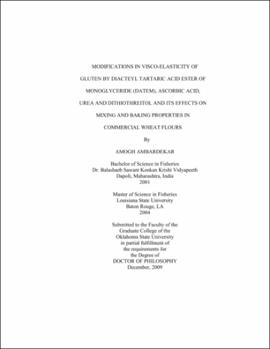| dc.contributor.advisor | Rayas-Duarte, Patricia | |
| dc.contributor.author | Ambardekar, Amogh | |
| dc.date.accessioned | 2013-11-26T08:22:30Z | |
| dc.date.available | 2013-11-26T08:22:30Z | |
| dc.date.issued | 2009-12 | |
| dc.identifier.uri | https://hdl.handle.net/11244/6581 | |
| dc.description.abstract | Scope and Method of Study: Quality and structure of gluten is one of the determining factors of baking quality in wheat flours. Changes in structure and quality of gluten at molecular level are dependent on different covalent and non covalent crosslinks, redox states and folding and unfolding of gluten during baking processes. Surfactants, oxidizing agents, reducing agents and chemicals like urea modify the structure of gluten at a molecular level changes the visco-elastic as well as reactive properties with other components of the flour resulting into improved or adverse effect on baking. DATEM, ascorbic acid, urea and dithiothreitol (DTT) were added to the gluten and the dough at different levels to measure the changes in visco-elasticity in gluten and mixing and baking properties of wheat flours with different protein content and quality. Six flours of different protein content and quality were procured from two sites in Oklahoma, three from each site. Visco-elastic properties of gluten extracted from flours were measured using creep recovery tests. Mixing properties were evaluated using a Farinograph and baking characteristics were assessed using standard 100 g flour pup loaves baking method. | |
| dc.description.abstract | Findings and Conclusions: DATEM treatments strengthened the structure of gluten as observed with various visco-elastic parameters during creep recovery experiments. While most of the visco-elastic properties were independent of baking and mixing properties of flours, oven spring rise was closely related with rheological parameters that explained increased viscosity like delta compliance (r = -0.57, P < 0.01) due to DATEM. The addition of ascorbic acid had no specific effect on the visco-elastic properties of gluten and mixing properties of flour. However, loaf quality improved with 100-150 ppm ascorbic acid showing significant correlations between recoverability of gluten and oven spring (r = -0.57, P <0.01). An overall weakening of the gluten strength resulted into dramatic decrease in baking and mixing characteristics of wheat flours with urea. Decrease in baking performance was related to slow rates of deformations and recovery of gluten due to urea indicated by significant correlations between loaf volume and creep time constants (r = -0.42, P < 0.05). Reducing effect of DTT on gluten weakened the gluten structure due to disulfide bond destruction resulting into poor baking supported by strong significant (P <0.01) correlations of separation time with proof and loaf heights (r = 0.56 and 0.53, respectively). The changes in visco-elasticity of gluten, mixing and baking properties of commercial wheat flours due to structural modification of gluten with different compounds were quantified. For the most part visco-elastic properties of gluten were independent of mixing and baking properties of flours with exceptions of few weak but significant correlations. This study concluded that 1 and 0.6% (w/w flour basis) DATEM strengthened gluten structure and improved bread quality, respectively. Ascorbic acid levels up to 100 ppm promoted disulfide linkages in gluten and improved baking. All levels of urea and DTT weakened the gluten strength due to disruption of hydrophilic and hydrophobic non-covalent bond and disulfide linkages resulting into poor baking performance. | |
| dc.format | application/pdf | |
| dc.language | en_US | |
| dc.rights | Copyright is held by the author who has granted the Oklahoma State University Library the non-exclusive right to share this material in its institutional repository. Contact Digital Library Services at lib-dls@okstate.edu or 405-744-9161 for the permission policy on the use, reproduction or distribution of this material. | |
| dc.title | Modifications in visco-elasticity of gluten by diacetyl tartaric acid ester of monoglyceride (DATEM), ascorbic acid, urea and dithiothreitol and its effects on mixing and baking properties in commercial wheat flours | |
| dc.contributor.committeeMember | McGlynn, William | |
| dc.contributor.committeeMember | Bellmer, Danielle | |
| dc.contributor.committeeMember | Maness, Niels | |
| osu.filename | Ambardekar_okstate_0664D_10538.pdf | |
| osu.accesstype | Open Access | |
| dc.type.genre | Dissertation | |
| dc.type.material | Text | |
| dc.subject.keywords | ascorbic acid | |
| dc.subject.keywords | creep-recovery | |
| dc.subject.keywords | datem | |
| dc.subject.keywords | dtt | |
| dc.subject.keywords | gluten | |
| dc.subject.keywords | urea | |
| thesis.degree.discipline | Food Science | |
| thesis.degree.grantor | Oklahoma State University | |
